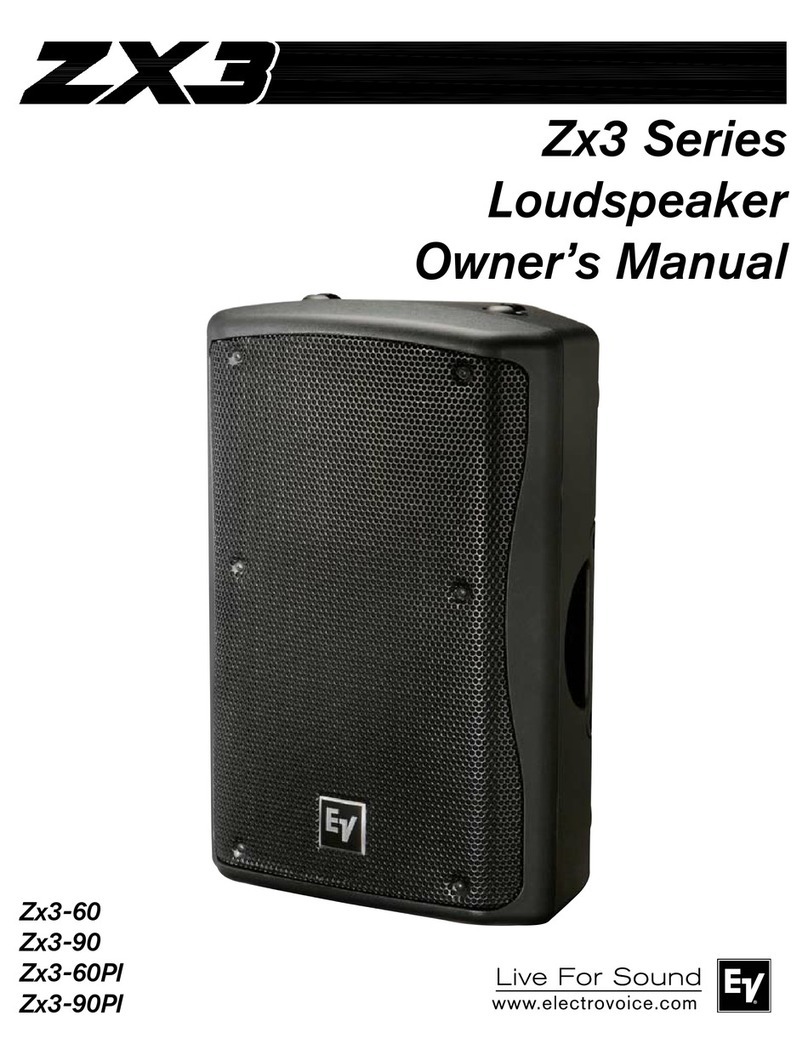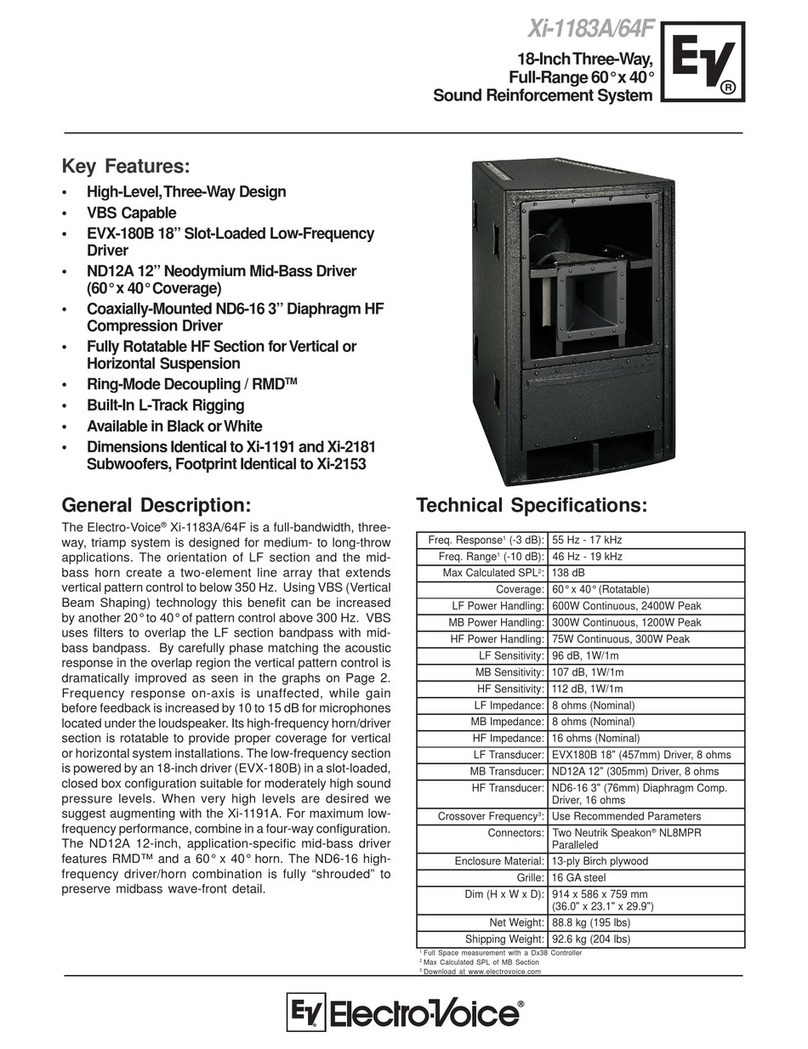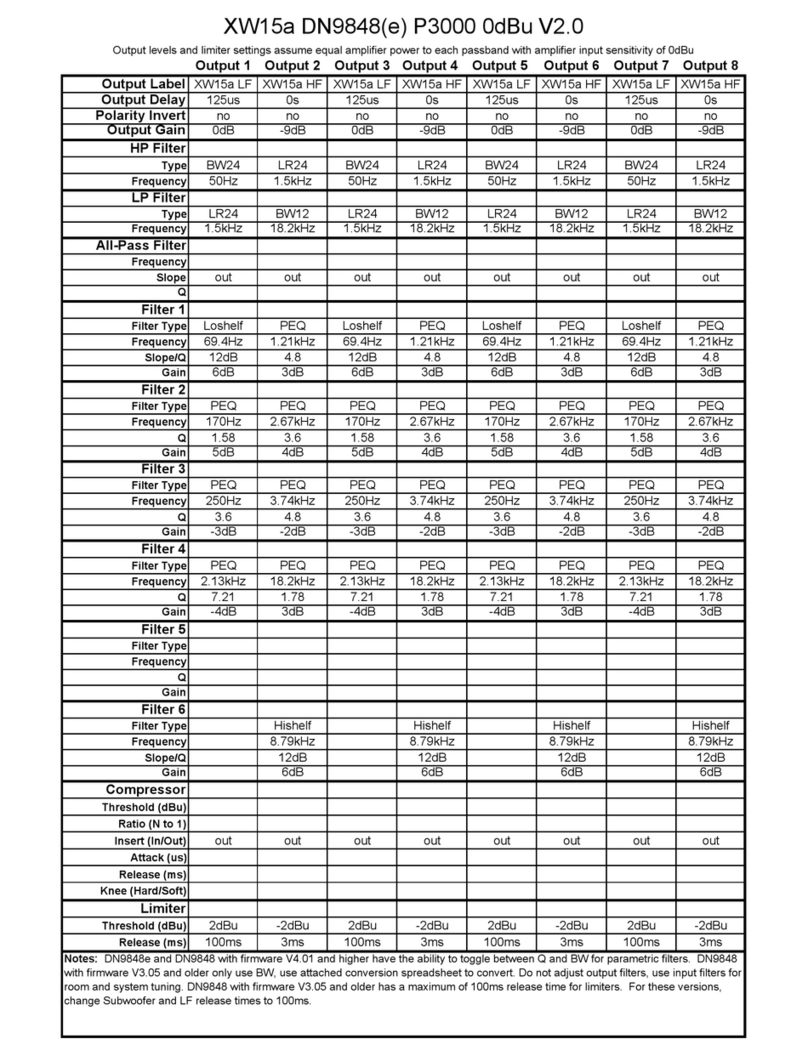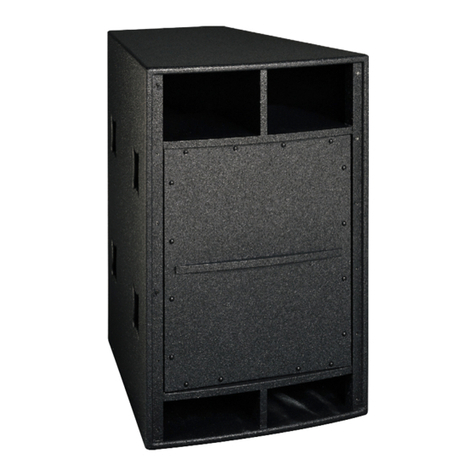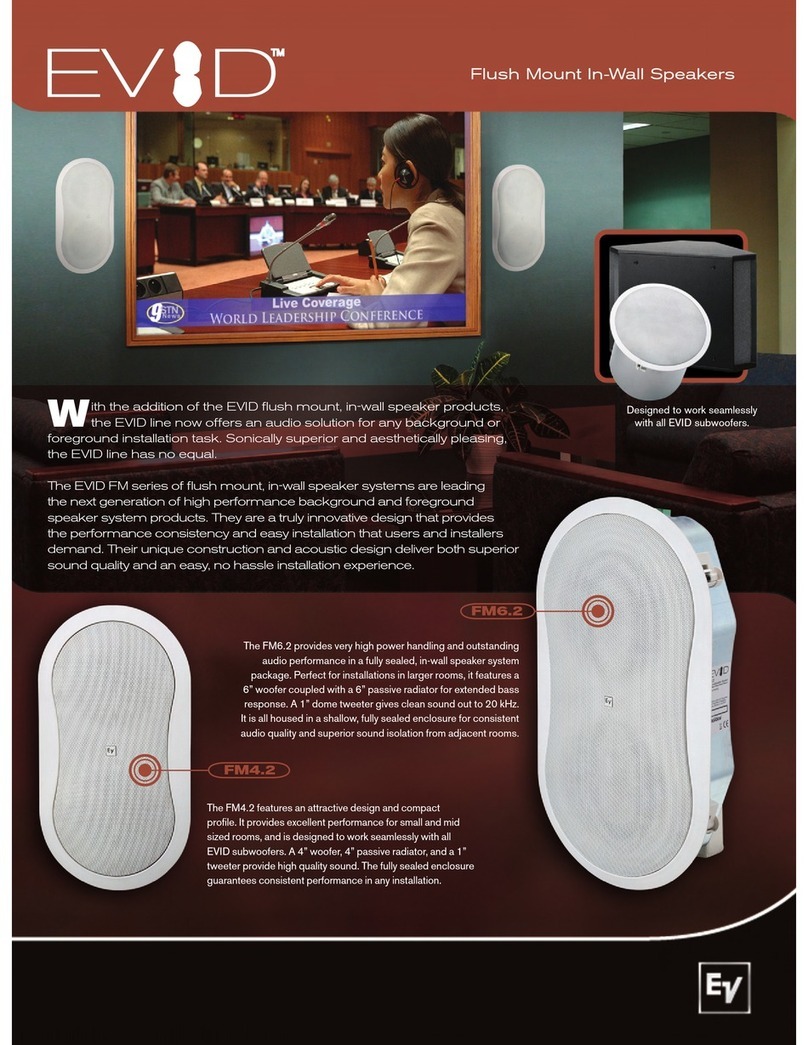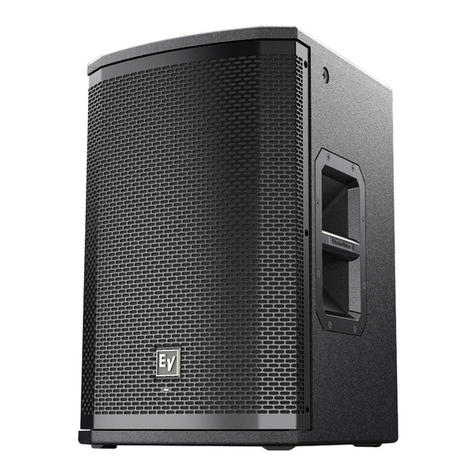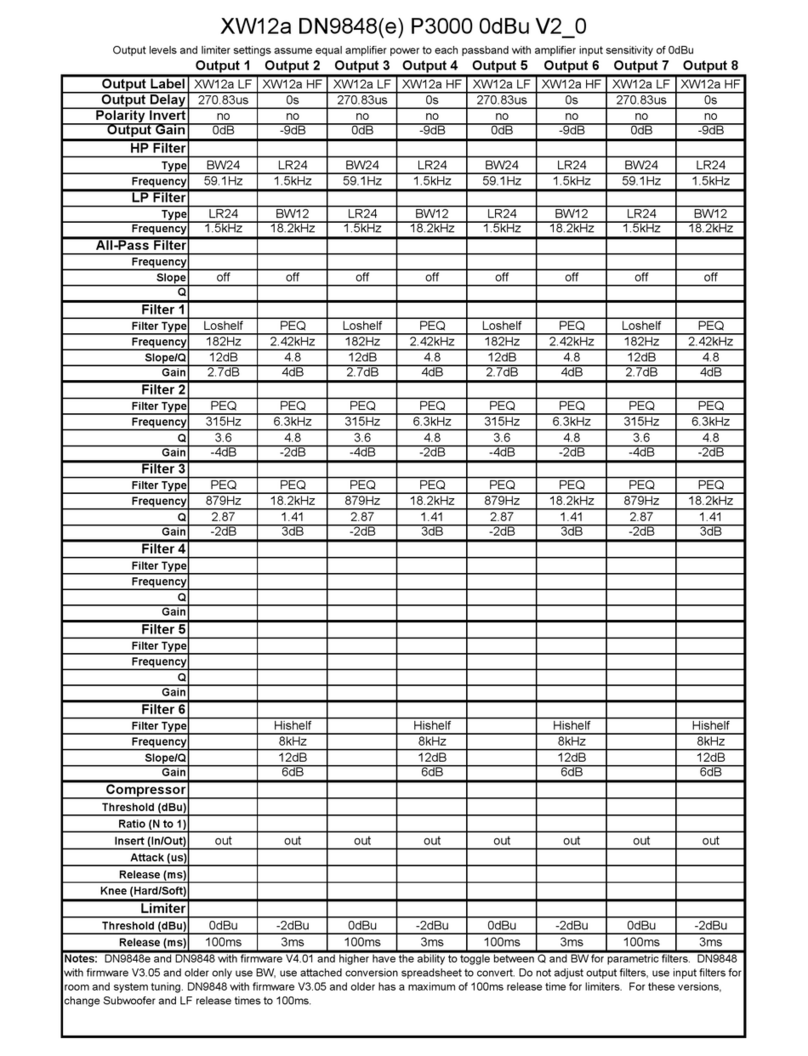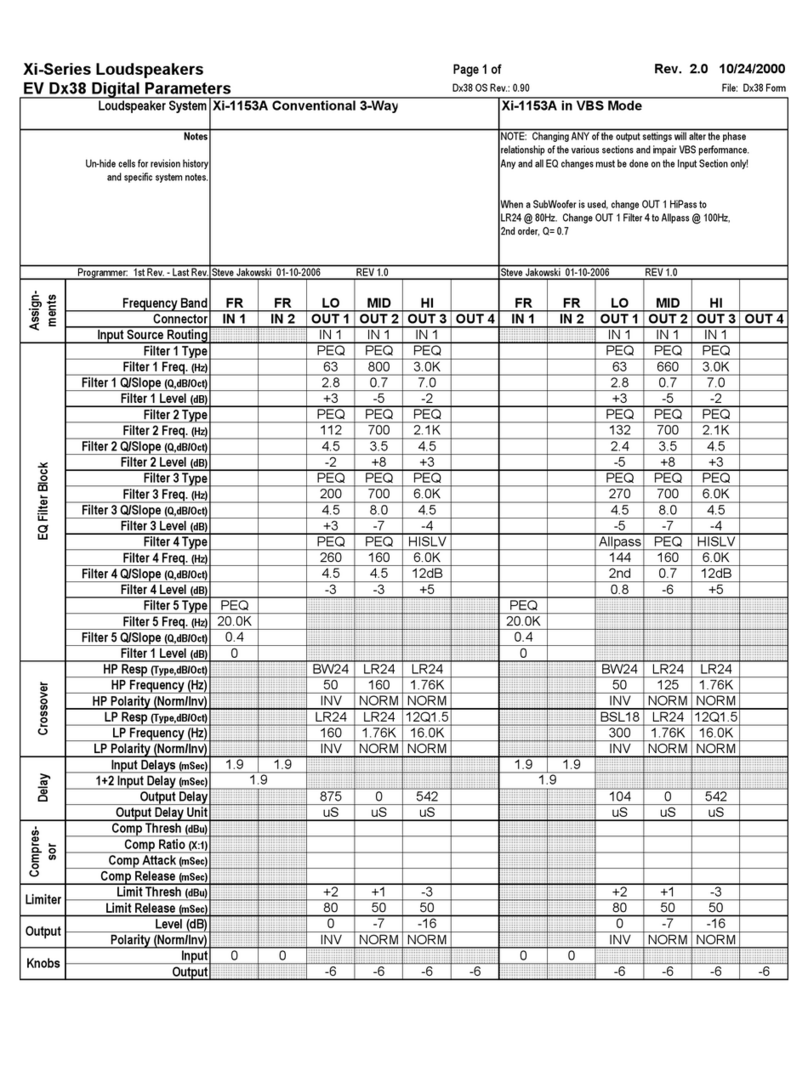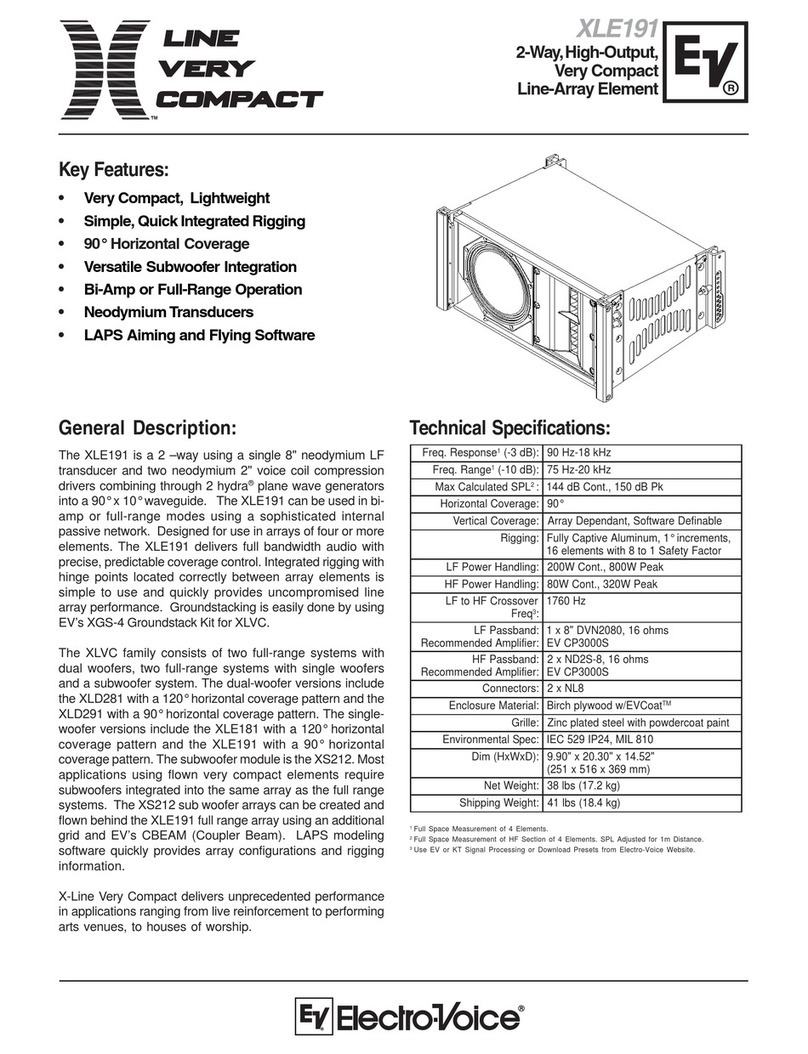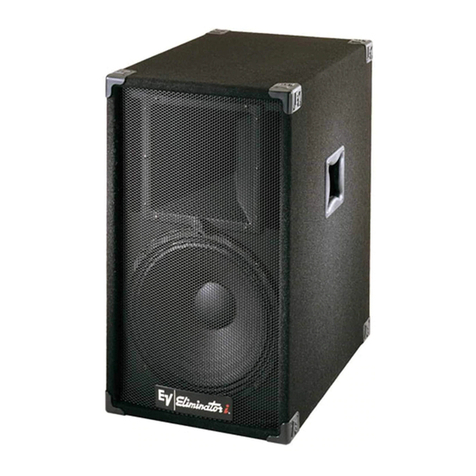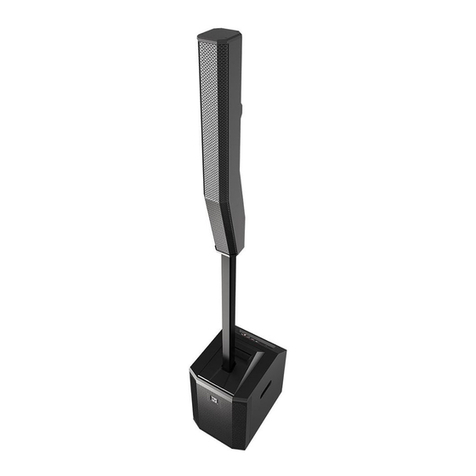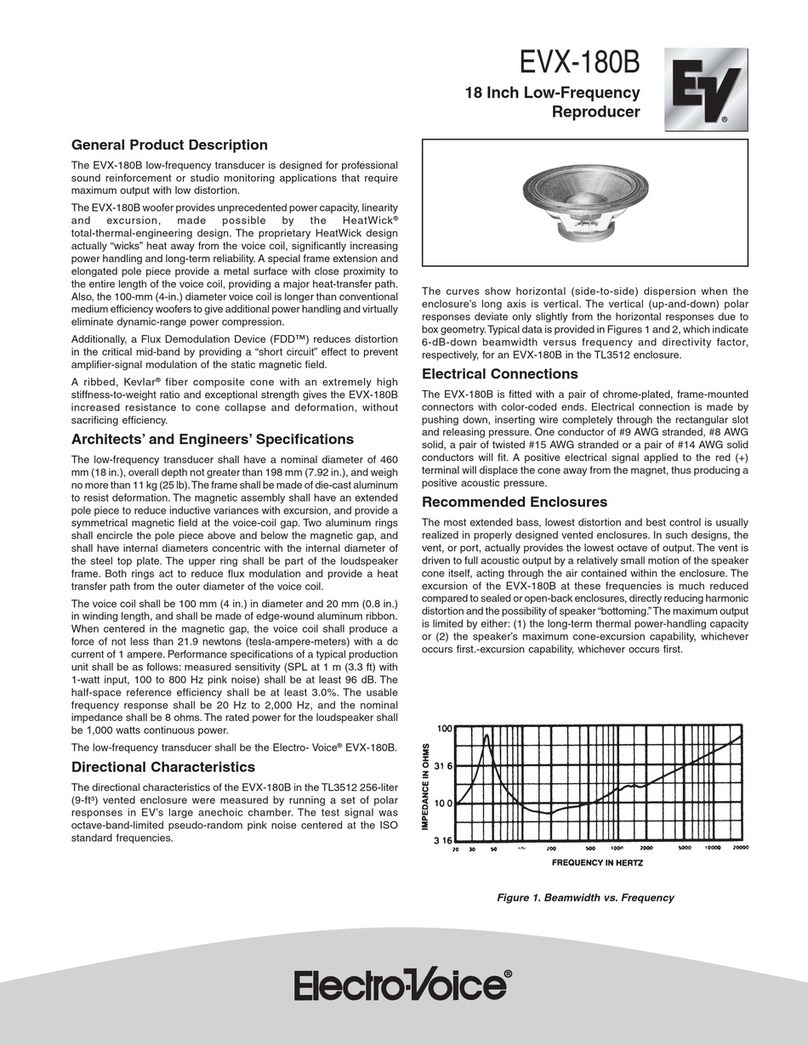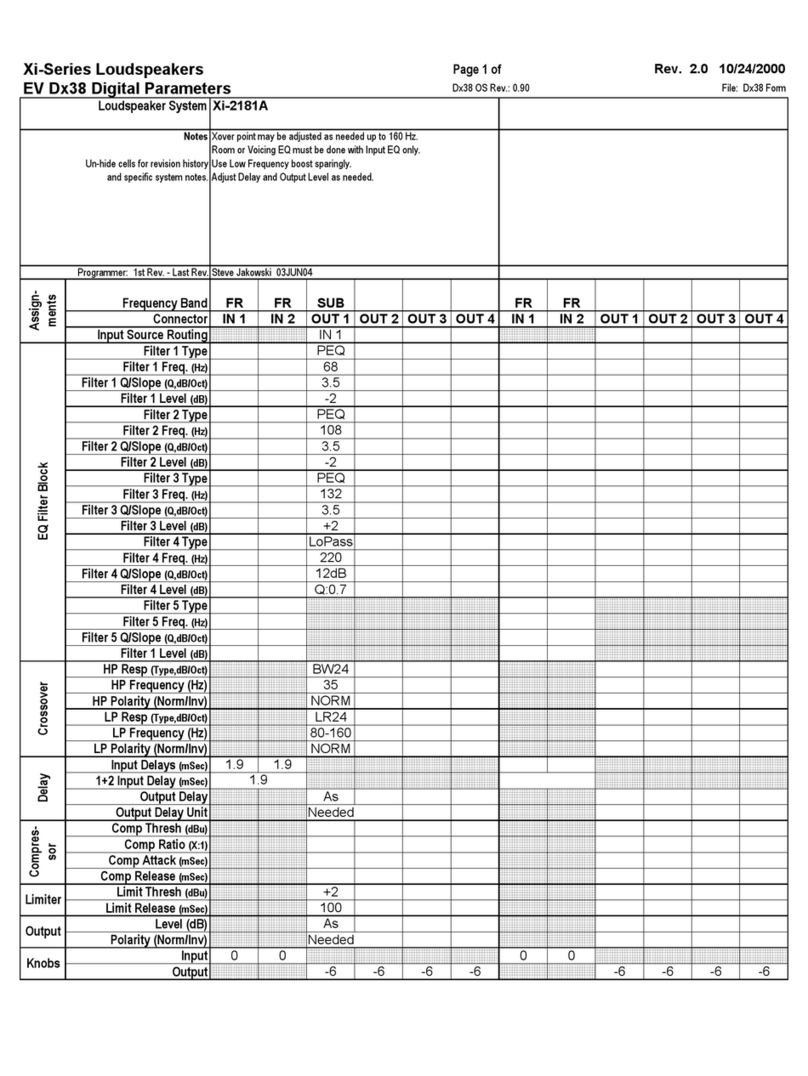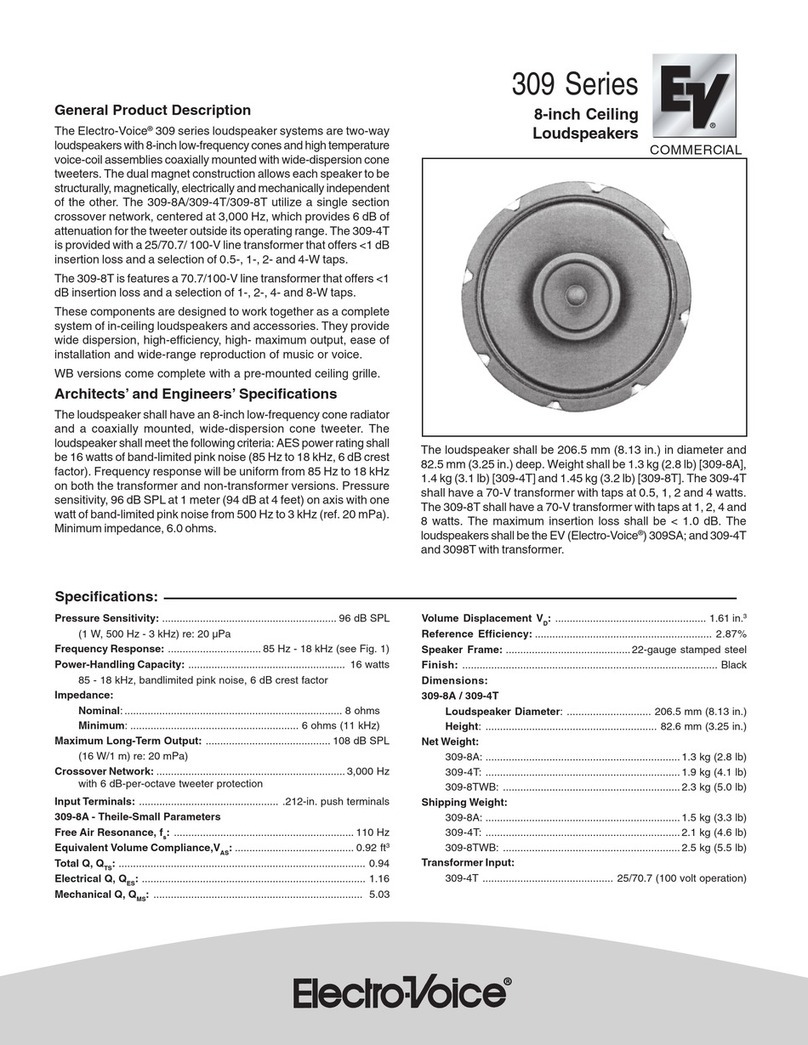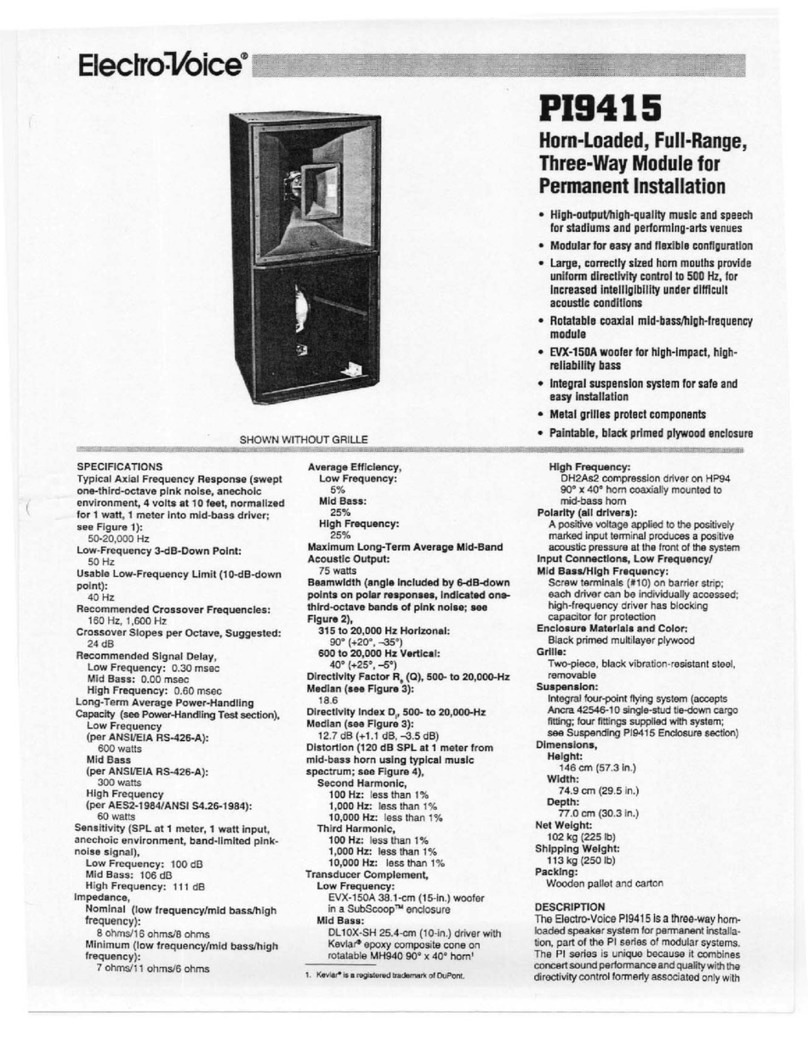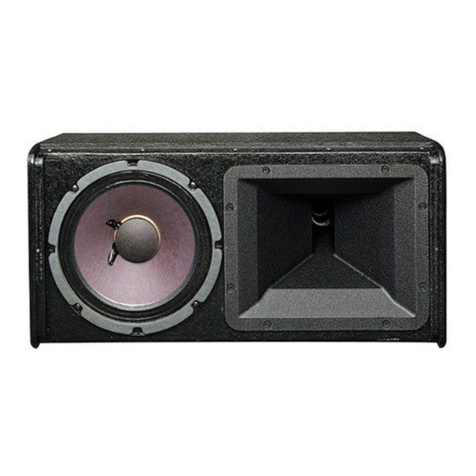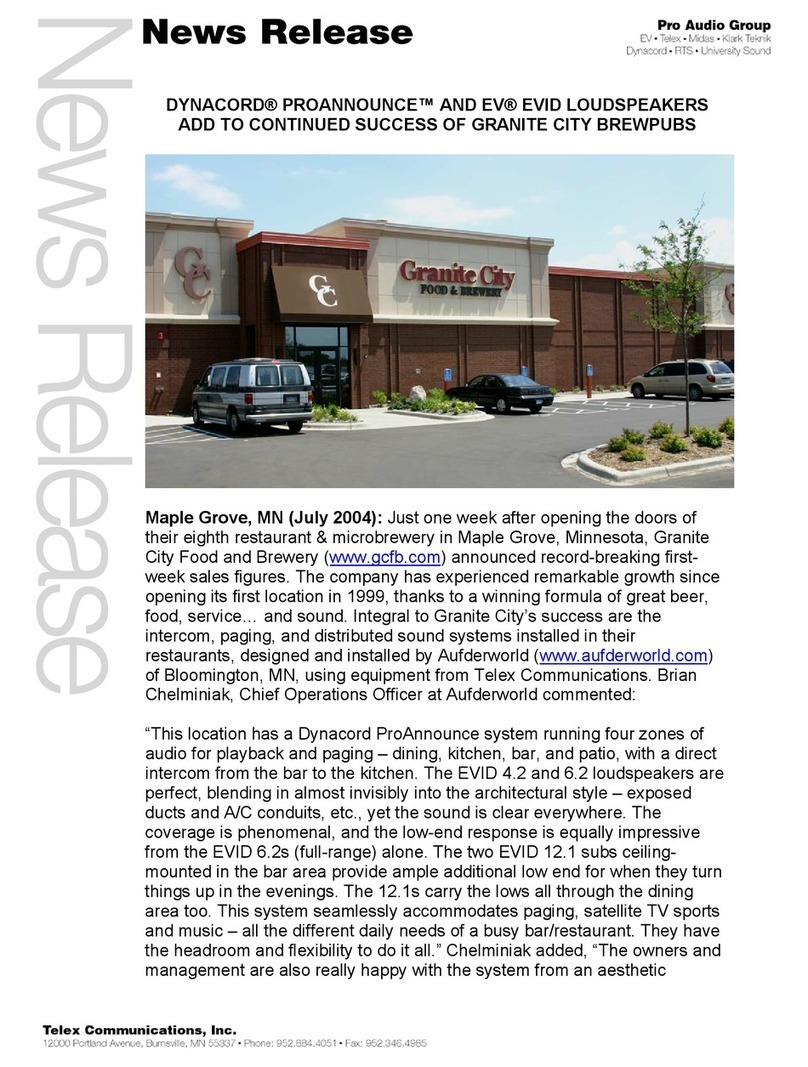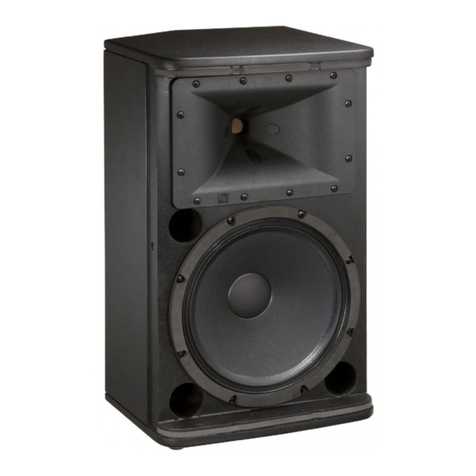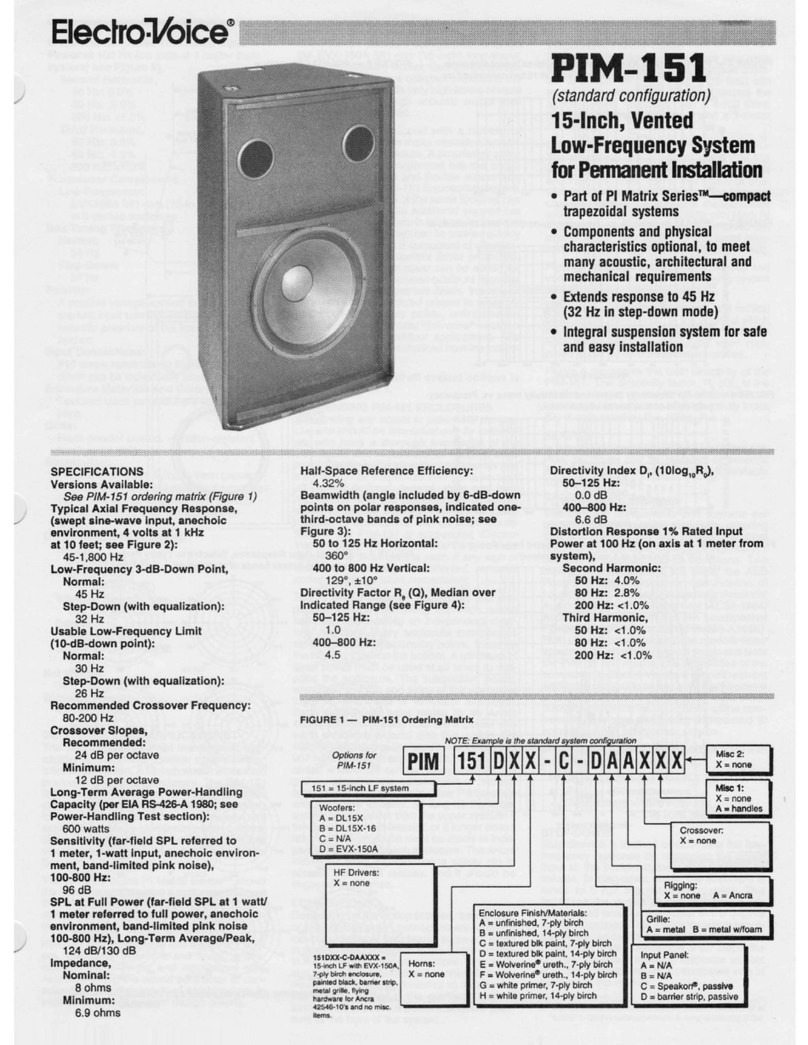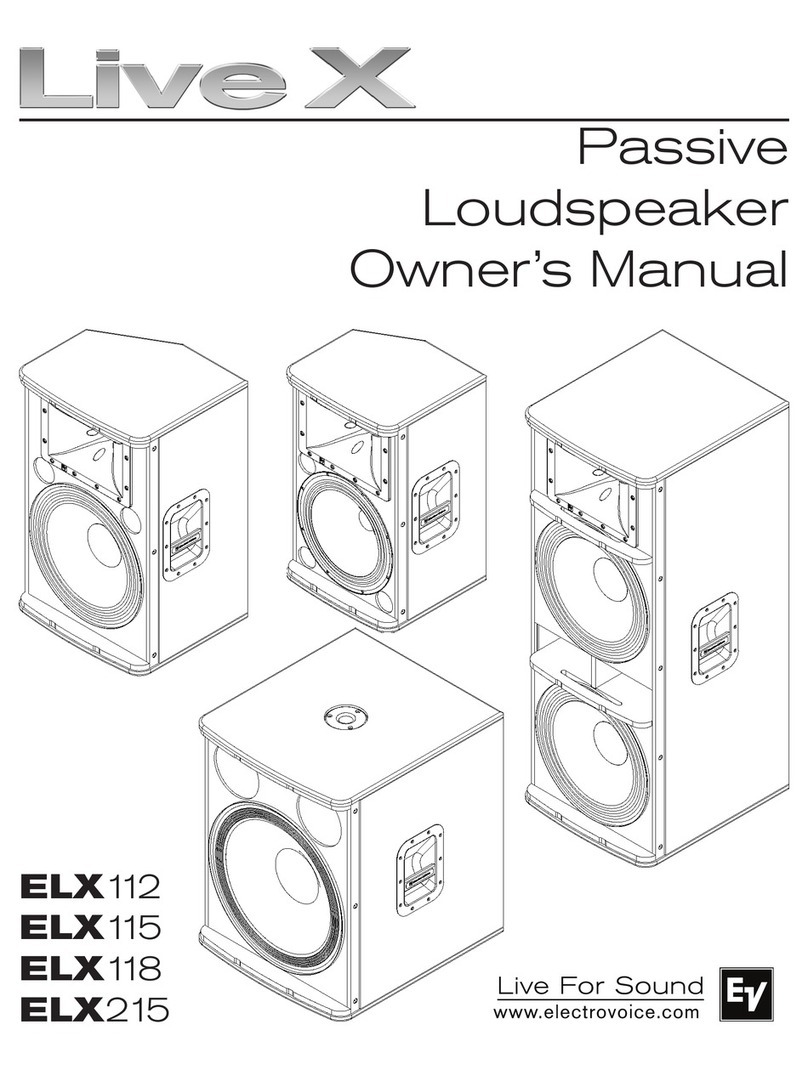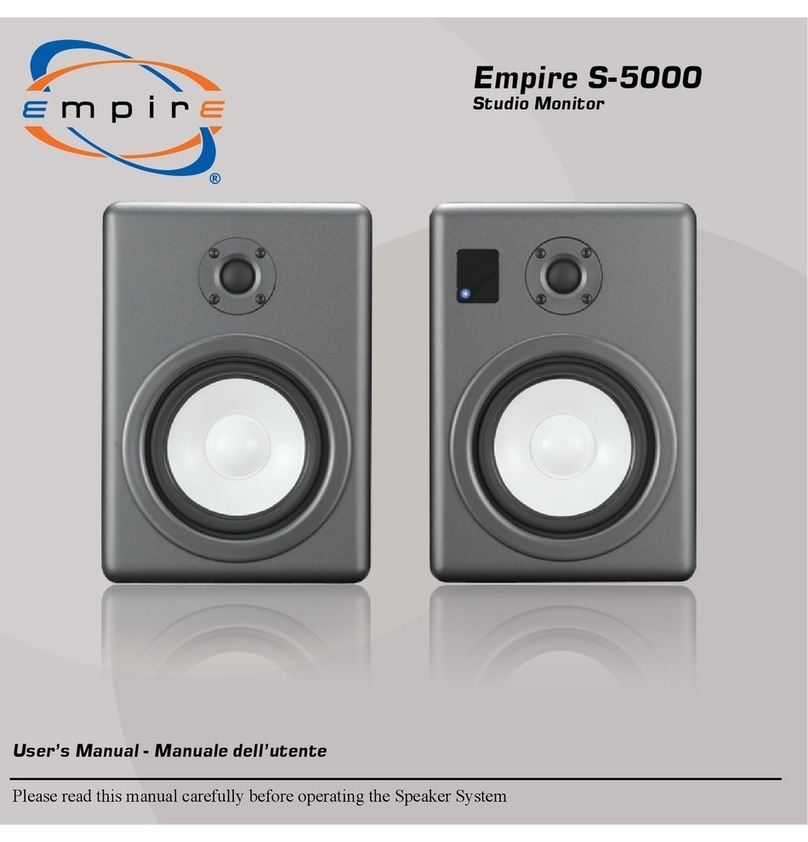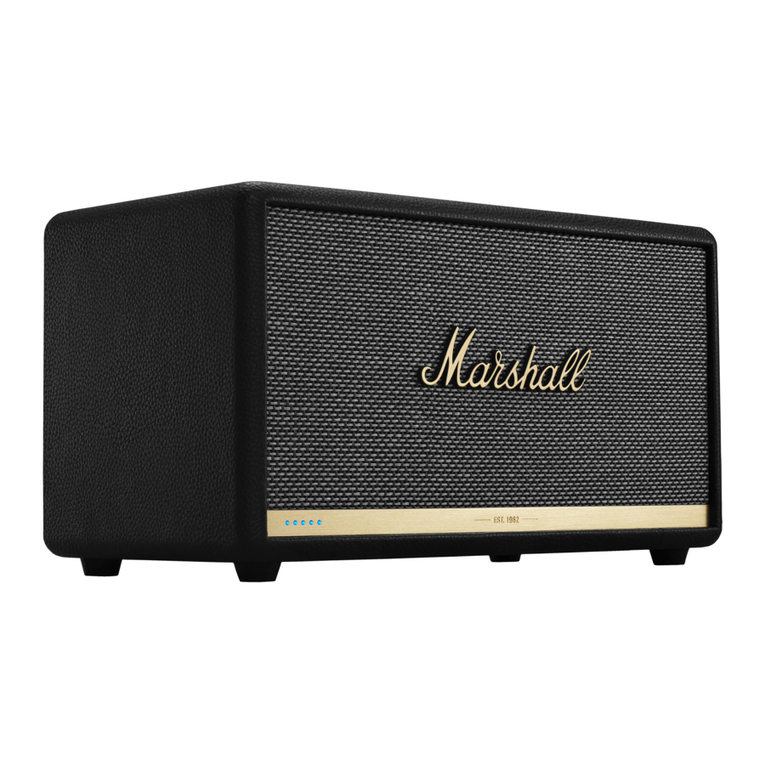
Eliminator Monitor
EliminatorMonitor
2
frompanelresonances.
The densely woven, industrial-grade, abuse-
resistantcarpetingprovidesafinishthat is both
attractiveandhighlydurable. Heavy-dutycor-
nerprotectors, firmly secured rubber feet,re-
cessed handles and a protective metal grille
completethepictureand ensure thattheElimi-
natorMonitorspeaker systemisideally suited
toa longand reliablelife on theroad.
Frequency Response
The combination of a 15-inch woofer, wide-
bandwidthhigh-frequencydriverandanequal-
izedcrossover resultsin thewide andsmooth
overall response shown in Figure 1. This re-
sponsewas measuredat 3.05meters (10feet),
using a 4-volt swept sine-wave input in an
anechoic chamber. No external equalization
was used. Figure 1 has been averaged and
corrected for 1 watt at 1 meter.
Connections
TheEliminator monitoris equippedwith two
parallel 1/4-inch phonejacks. (The Elimina-
torMonitorE versionhastwo parallel Neutrik
Speakon®NL4MPconnectors.) Another sys-
tem can be connected in parallel by using the
other connector. Care must be taken not to
abusetheamplifierby connectingimpedances
whichare toolow.
Constant-Directivity Speaker System
Thecrossover frequencyand speaker compo-
nentgeometries have beenselected so thatthe
directional characteristics of the woofer and
constant-directivityhornmatchatthecrossover
frequency to create a special system type —
theconstant-directivitysystem. At higher fre-
quenciesthe verticalcoverage patternremains
constantandthehorizontalpatternsmoothlytran-
sitionstoa55° angle above5,000Hz. Response
withinthe80°x55° rated coverageangle isuni-
form,whichmeansdependablecoveragewith-
out “hot spots” or dead zones at certain fre-
quencies. The80° x 55°dispersion character-
istic also helps avoid early reflections from
nearby surfaces which could degrade perfor-
mance. Thecontrolled directivity ofthe high-
andlow-frequencytransducersalso eliminates
responseirregularitiescausedbydiffractionoff
nearby enclosure edges and, in combination
with an essentially flat on-axis frequency re-
sponse, produces a total acoustic power out-
putthatisuniformwithfrequency.
Directivity
Aunique featureof theEliminator Monitoris
theconstant-directivitydispersionprovidedby
the80° x 55°horn. The polarresponse of the
systematselected one-third-octavebandwidths
is shown in Figure 5. These polar responses
weremeasured in ananechoic environmentat
6.1 meters (20 feet) using one-third-octave
pink-noiseinputs. Thefrequenciesselectedare
fullyrepresentativeofthepolarresponse of the
system. Beamwidthofthesystemutilizing the
completeone-third-octavepolar data isshown
inFigure6. Directivity factor,R, anddirectiv-
ityindex, Di,are plotted inFigure 7.
Power-HandlingCapacity
Electro-Voice components and systems are
manufacturedto exactingstandards, ensuring
theywillhold up,notonlythroughthemostrig-
orousof powertests, but also through contin-
ued use in arduous, real-life conditions. The
EIA Loudspeaker Power Rating Full Range
(ANSI/EIA RS-426-A 1980) uses a noise
spectrumwhichmimicstypical musicand tests
the thermal and mechanicalcapabilitiesofthe
components. Electro-Voice will support rel-
evant additional standards as and when they
become available. Extreme, in-house power
tests,which push theperformance boundaries
ofthe woofers,arealso performedand passed
toensure yearsof trouble-freeservice.
Specifically, the Eliminator Monitor passes
ANSI/EIA RS-426-A 1980 with the follow-
ingvalues:
RSR = 5.10 ohms (1.15 x RE)
PE(MAX) = 300 watts
Testvoltage =39.10 voltsrms,
77.33 volts peak (+6dB)
The “peak” power-handling capacity of a
wooferis determinedby thepeak testvoltage
amount. Forthe EliminatorMonitor, a77.33-
volt-peak-test voltage translates into 1,200-
wattsshort-term peakpower-handling capac-
ity. This is the equivalent of four times the
“average” power-handling capacity, and is a
peakthatcan be sustainedforonlya few milli-
seconds. However, thissort of short duration
peakis very typicalin speech andmusic. Pro-
vided the amplifier can reproduce the signal
accurately,withoutclipping,thewooferwillalso
performaccurately andreliably, evenat these
levels.
AmplifierPowerRecommendations
Asnoted inthe Power-HandlingCapacity sec-
tion, above, the Eliminator Monitor has a
random-noise power capacity of 300 watts
long-term (1,200-watts peak)per ANSI/EIA
RS-426-A1980. Thefollowingguidelineswill
helprelatethis toanappropriate powerampli-
fieroutputrating.
1. To use the Eliminator Monitor to full ca-
pacity,skilledexpertsinsound-systemin-
stallationandoperationwillobtainthebest
resultsif the poweramplifier is2.0to 4.0
timesthe long-term averagenoise power
ratingofthespeakersystem. FortheElimi-
nator Monitor this is 600 to 1,200 watts.
The caution cannot be made strongly
enough,however,thatthisarrangement is
onlyforexperts orthosewhocandiscipline
themselves against “pushing” the system
for ever-higher sound levels and who can
avoid “accidents” such as catastrophic
feedbackor droppedmicrophones.
2. Amoreconservative,“normal” amplifier
size, which will produce audible results
nearly equal to those of the “expert” rec-
ommendation,is1.0to1.4 times thelong-
term average noise power rating of the
speaker. For the EliminatorMonitor this
is 300 to 450 watts.
3. To be very conservative, one can use an
amplifierratedat0.5to0.7timesthelong-
term average noise power rating of the
loudspeaker. FortheEliminator Monitor
this is 125 to 175 watts.
Request P.A. Bible Addition No. Two
(“Power-HandlingCapacity”) formoreback-
groundonthese recommendations.
Service
In the unlikely event the EliminatorMonitor
requires service, the woofer and driver can
both be replacedorserviced fromthefront. A
servicedatasheetisavailablefromElectro-Voice.
